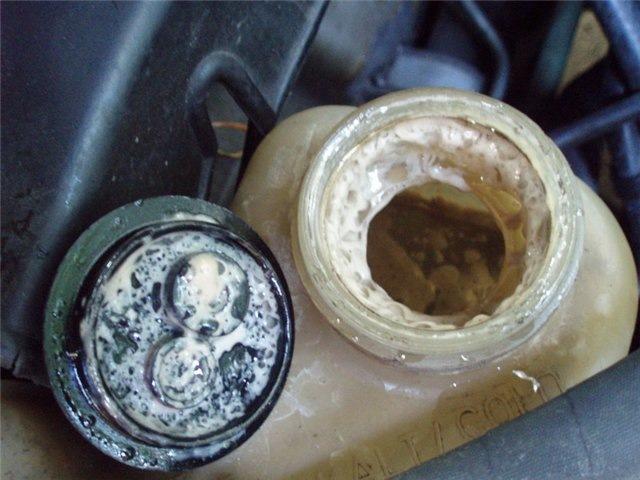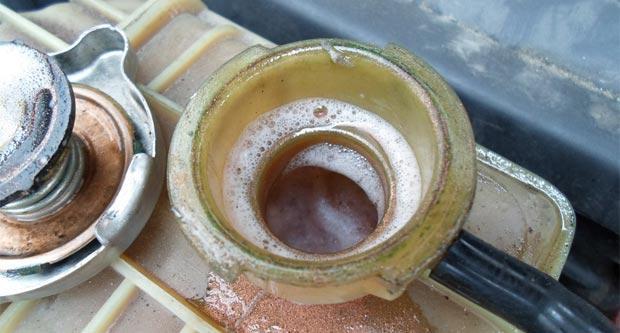
Why does antifreeze foam in the expansion tank?
Cylinder head gasket
Perhaps the most common cause of foam in the expansion tank is a leaky gasket under the cylinder head (cylinder head). However, with this malfunction, there are three scenarios for the development of events with different manifestations and varying degrees of danger to the motor.
- Exhaust gases from the cylinders began to penetrate into the cooling system. In this situation, exhausts will begin to be forced into the cooling jacket. This will happen because the pressure in the combustion chamber will be higher than in the cooling system. In some cases, when the tunnel between the cylinder and the cooling jacket pierced in the cylinder head gasket is large enough, antifreeze will be injected into the cylinder during the suction stroke due to vacuum. In this case, there will be a drop in the level of antifreeze in the system and a characteristic soaring from the exhaust pipe. In terms of car operation, this breakdown will manifest itself as a systematic overheating of the motor due to gas plugs. The foam itself in the tank will look more like bubbling soapy water. Antifreeze may darken slightly, but will not lose transparency and its working properties.


- The cooling system circuit intersects with the lubrication circuit. In most cases, with this breakdown, the penetration becomes mutual: antifreeze enters the oil, and oil seeps into the coolant. In parallel, an abundant emulsion will form - a beige or brown oily mass, the product of active mixing of water, ethylene glycol, oil and small air bubbles. Antifreeze, in especially advanced cases, will turn into an emulsion and begin to be squeezed out through the steam valve in the plug of the expansion tank in the form of a beige liquid emulsion. The oil level will rise, and emulsion will also begin to accumulate under the valve cover and on the dipstick. This breakdown is dangerous in that two vital systems for the internal combustion engine suffer at the same time. The lubrication of loaded nodes deteriorates, heat transfer drops.


- The gasket burned out in several places, and all three separate circuits were intertwined. The consequences can be the most unpredictable: from overheating and the appearance of foam in the expansion tank to water hammer. Water hammer is a phenomenon associated with the accumulation of a large amount of antifreeze or any other liquid in the cylinder. The liquid does not allow the piston to rise to top dead center, as it is an incompressible medium. At best, the engine won't start. At worst, the connecting rod bends. This phenomenon is rarely observed in small-displacement in-line ICEs. Water hammer due to a leaky cylinder head gasket is more common in large V-shaped engines.
Such a breakdown is repaired exclusively by replacing the cylinder head gasket. In this case, two standard procedures are usually performed: checking the head for cracks and assessing the contact planes of the block and cylinder head. If a crack is found, the head must be replaced. And when deviating from the plane, the mating surface of the block or head is polished.


Other reasons
There are two more malfunctions that answer the question: why is the antifreeze foaming in the expansion tank.
- Inappropriate or poor quality fluid in the system. A real case is known when an independent, but inexperienced driver girl poured ordinary perfumed windshield washer fluid into the cooling system. Naturally, such a mixture not only slightly tinted the tank and forever captured the trace of this ridiculous mistake, but due to the presence of surfactant, it foamed. Such errors are not critical and will not lead to a sharp failure of the internal combustion engine. You just have to flush the system and fill in the regular coolant. A rare case today, but antifreeze can also foam in the expansion tank due to poor quality.
- Overheating of the motor with simultaneous malfunction of the steam valve. In this case, splashing of part of the coolant through the valves in the form of a hissing, foaming mass is observed. Under normal conditions, when the valve in the plug is in good condition, the coolant, when overheated, will intensively and quickly splash out of the system. If the plug does not function as it should, then this can lead to rupture or breakdown of the pipes from the seats and even the destruction of the radiator.
The conclusion here is simple: do not use unsuitable fluids for the cooling system and monitor the temperature of the motor.


Watch this video on YouTube